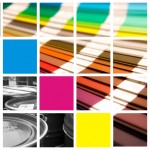C olor in Print Advertising: Are You Sending Hidden Messages?
olor in Print Advertising: Are You Sending Hidden Messages?
A printed marketing piece — whether a brochure, flyer, catalog, or letter — contains many design components. From margin size to font, use of white space to size and type of paper, the elements that go into a printed piece require much consideration. But when it comes to color, marketers all too often make choices based on personal preference, anecdotal evidence, or even hunches.
However, people actually devote time and effort to studying this stuff; researchers have uncovered a large body of quantitative data about the many ways color affects consumer behavior. Their findings can help inform color choices, so printed projects can better reach their intended audiences.
How Important is Color in Marketing?
In a nutshell: Very. A study by the Seoul International Color Expo found that almost 93 percent of consumers said visual experience is the most important factor when it comes to purchasing. Of these, almost 85 percent listed color as the major factor. Even more impressive, a report from the Institute for Color Research notes that most consumers make a judgement about a product within 90 seconds of first seeing it and that color accounts for 62 to 90 percent of their initial impression.
Color is also key in branding; a University of Maryland study found that using a consistent color palette increased brand recognition by a whopping 80 percent! Why? It’s all about brain chemistry; our neurocircuitry is hard-wired to respond to color. Multiple studies indicate that color significantly improves mental processing, storage, and memory. And if you’re still not convinced, consider that colorful ads are read 42 percent more often than black-and-white ads. Readers also tend to spend more than twice as long lingering on a colorful ad than on a black-and-white ad.
These numbers aren’t exactly ambiguous — color matters (a lot!) when it comes to marketing. But which colors are best?
Color Choice for Intended Results
While each individual reacts to colors in their own way, research indicates there are some common themes associated with colors. In fact, certain colors actually trigger biological responses, some of which improve attention and evoke emotions.
Red: Studies indicate that consumers tend to associate red with attention, vigilance, excitement, stimulation, and enhanced concentration. When products are featured on a red background, readers tend to have more positive thoughts about the product if specific descriptors are used, rather than creative or evocative language.
Blue: In contrast, readers preferred emotive, creative descriptions for products featured on a blue background. The cool color blue tends to elicit feelings of calm, safety, and openness, which can open the door to creative expression and exploration.
Yellow and Orange: Like red, these warm colors evoke feelings of excitement and attention. Orange tends to be associated with extroversion and energy, while yellow is often seen as optimistic and friendly.
Green and Brown: Both green and brown are associated with nature, making these colors effective for outdoorsy, rugged, or natural products or campaigns. In addition, green is associated with security, while brown is linked to seriousness.
Pink and Purple: Pink and purple both evoke associations with femininity and sophistication. Purple also connotes luxury and authenticity.
Black: For the ultimate in elegance and sophistication, nothing beats black. Glamor, power, dignity, and high-fashion are all evoked by the use of black.
White: As the absence — or complete reflection — of all colors, white evokes feelings of purity, simplicity, and cleanliness. It’s also associated with happiness and peace.
When choosing colors or combinations for your print ads, keep these associations in mind. Select colors that support your messaging, rather than subconsciously undermining it.
